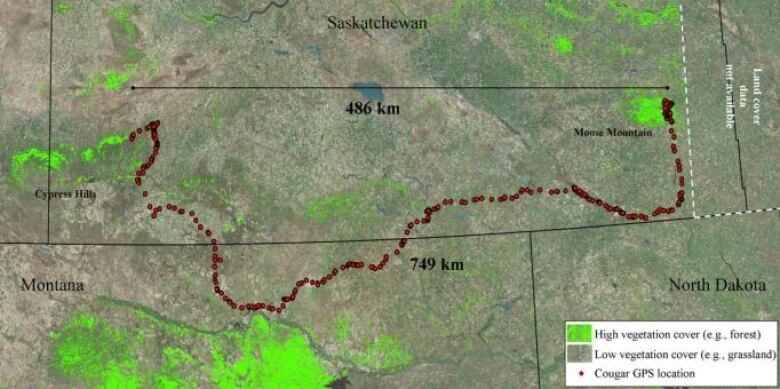'A banner year' for cougars in Manitoba: 40 reports, 5 confirmed sightings in 2020
Cat virtually disappeared from province in late 1800s, but is slowly reappearing, zoologist says

The odds of seeing a cougar in Manitoba appear to be getting better.
With 40 reported sightings and five confirmed, 2020 saw the most cougar interactions one zoologist can remember in his nearly two decades with Manitoba Conservation'swildlife and fisheries branch.
"[It was] a banner year in many respects," biodiversity conservation zoologist Bill Watkins told CBC's Weekend Morning Show host Nadia Kidwai.
Three of those sightings were confirmed with trail photographs of the animals, while the other two were verified by dead animals being turned in, he said.
Watkins said cougar sightings have been on a slow, steady rise in Manitoba for the past 20 years, and last year's high number could be a sign the big cats are starting to repopulate the province.
That could be partly because more people carry trail cameras and cougar populations seem to be increasing west of Manitoba, he said.
"They're elusive, they're beautiful and we don't know a whole lot about them in Manitoba," he said, adding that's in part because the animals virtually disappeared from the province when settlers arrived in the late 1800s.
Since 2000, there have been more than 900 reported cougar sightings in Manitoba, including 35 that were confirmed, he said.

About 80 per cent of the verified sightings happened in western Manitoba, between Turtle Mountain Provincial Park near the Canada-U.S. border and Porcupine Hills near Saskatchewan,he said.
Cougars are the second-largest cat in North America, at nearly three metres long from nose to tail and about a metre high at the shoulder, Watkins said.
They mostly eat deer, but sometimes go for species like elk, or smaller animals like beavers and porcupines if they're unsuccessful in hunting deer, he said.
What if you see one?
While some people are nervous about running into a cougar, Watkins said he's not aware of the animal ever attacking a person in Manitoba but it's still important to know what to do if you see one.
"The first thing is count your lucky stars that you actually got to see one of these rare and beautiful animals. But the second thing is to make sure it's got room to escape. Don't try to corner it or in any way control its movements. Just let it go," he said.
If it doesn't retreat, you should slowly move to a safe place while keeping your eyes on it, making noise and throwing things at it, he said. If you have small children with you, pick them up and walk away slowly.
"Cougars are ambush hunters, and if they know that they've been observed and they're being watched, that tends to short circuit their predatory instincts and they don't attack."
And under the worst possible circumstances if the animal did attack Watkins says fight back if you can.
"These animals tend to be only in the neighborhood of a little over 100 pounds, so it is quite possible to fight one off," he said.
Watkins is hosting a webinar at 6:30 p.m. CT Saturday where he'll teach participants more about the big cat.
"We're lucky to experience this recolonization right now," he said. "I just hope that before I retire, I will be able to [say] that I have seen one in Manitoba and even better, one with kittens."
With files from Nadia Kidwai












_(720p).jpg)


 OFFICIAL HD MUSIC VIDEO.jpg)
.jpg)



























































































